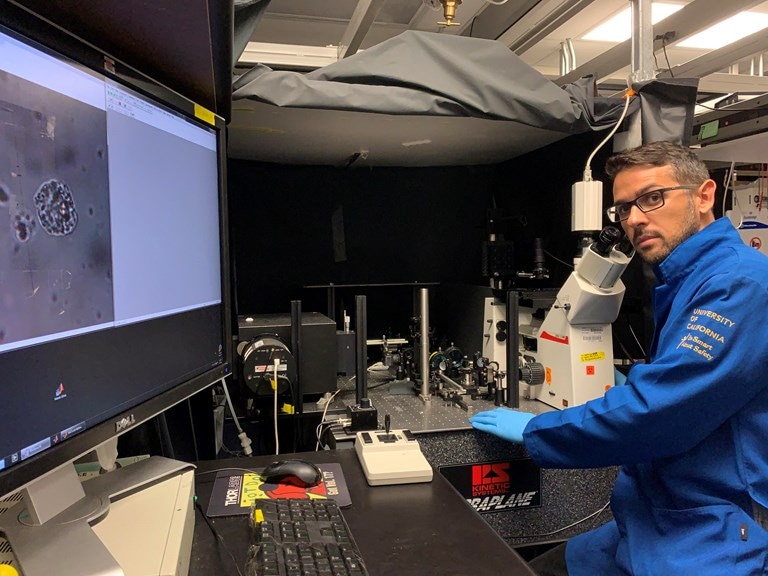Aug 6 2019
Scientists have revealed that Raman spectroscopy, an optical method, can be employed to distinguish between benign and cancerous thyroid cells.
 Marcos A. S. de Oliveira, first author of the paper, uses a line-scan Raman microscope to rapidly acquire Raman signals from the entire cell volume. This approach more accurately captures the chemical composition of an entire cell. (Image credit: Marcos A. S. de Oliveira, University of California, Davis)
Marcos A. S. de Oliveira, first author of the paper, uses a line-scan Raman microscope to rapidly acquire Raman signals from the entire cell volume. This approach more accurately captures the chemical composition of an entire cell. (Image credit: Marcos A. S. de Oliveira, University of California, Davis)
The new research exhibits the ability of Raman spectroscopy as a tool to enhance the diagnosis of thyroid cancer, which is the ninth most widespread cancer with over 50,000 new cases diagnosed in the United States every year.
Our encouraging results show that Raman spectroscopy could be developed into a new optical modality that can help avoid invasive procedures used to diagnose thyroid cancer by providing biochemical information that isn’t currently accessible. This could have a major impact in the field of pathology and could lead to new ways to diagnose other diseases.
James W. Chan, University of California, Davis
A multidisciplinary group headed by Chan; Michael J. Campbell from University of California, Davis, and Eric C. Huang from University of Washington, Seattle report in The Optical Society (OSA) journal Biomedical Optics Express that their Raman spectroscopy method can differentiate between healthy and cancerous human thyroid cells with an accuracy of 97%.
“We are the first, to our knowledge, to use human clinical thyroid cells to show that Raman spectroscopy can identify cancer subtypes at the single-cell level,” stated Chan. “However, we will need to increase both the number of cells and number of patients studied to confirm the accuracy of the Raman technique.”
Improving Cell-Based Diagnosis
A common symptom of thyroid cancer is a lump—or nodule—in the neck. However, the majority of the thyroid nodules are not cancerous. Ultrasound-guided fine-needle aspiration biopsies are normally employed to test cancer by inserting a thin needle into the nodule to get cells that are prepared on a microscope slide, stained, and examined by a pathologist.
In around 15%–30% of cases, the pathologist is unable to decide whether cells obtained from the biopsy are malignant or benign. These cases require a surgical procedure called a thyroidectomy to remove tissue, which offers more information for a more accurate diagnosis.
The scientists employed Raman spectroscopy as a potential solution since it is a non-invasive method that does not need any sample preparation or staining to find out slight differences in the molecular composition of complex samples like cells.
“We would like to use Raman spectroscopy to improve the pathologist’s analysis of the cells obtained with fine needle aspiration to reduce the number of thyroidectomies necessary,” stated Chan. “This would both minimize surgical complications and reduce health care costs.”
Biochemical Information from an Entire Cell
For the new research, the scientists employed a line-scan Raman microscope that enabled them to quickly capture Raman signals from a whole cell volume. Through this, they could more precisely acquire the chemical composition of whole cells in comparison with other methods that obtain a Raman spectrum from only part of a cell’s volume.
Multivariate statistical techniques and classification techniques were subsequently employed to analyze the Raman data and categorize the cells in an objective, unbiased manner.
The scientists applied this Raman spectroscopy method to individual cells segregated from 10 patient thyroid nodules diagnosed as benign or cancerous. The data analysis found out unique spectral differences that could differentiate cancerous cells from benign ones with a diagnostic accuracy of 97%. In addition, they demonstrated that other subtypes could be determined by their spectral differences.
These preliminary results are exciting because they involve single cells from human clinical samples, but more work will need to be done to take this from a research project to final clinical use.
James W. Chan, University of California, Davis, U.S.A
Besides testing it on more cells and patients, the scientists must also apply the method to cells acquired with fine-needle aspiration and test it on samples for which the pathologist cannot find out whether the cells are cancerous or benign. Furthermore, they wish to create an automated prototype system that can carry out the Raman measurements and analysis with less human involvement.